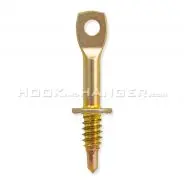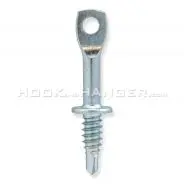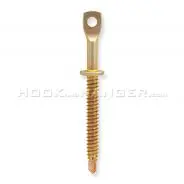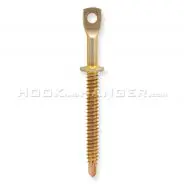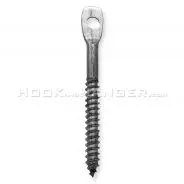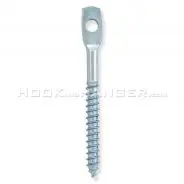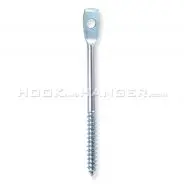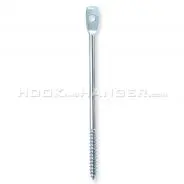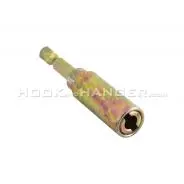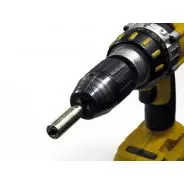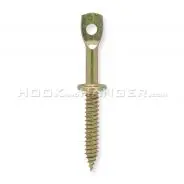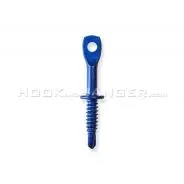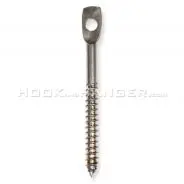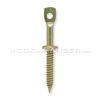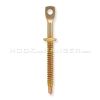
Eye Lag Screws
When it comes to securely anchoring ceiling wire or supporting overhead systems, eye lag screws are one of the most dependable and widely used fasteners on the job. These threaded screws with a looped head are designed to drive directly into wood, metal, or drywall substrates, providing a fixed point for wire suspension. Whether you're installing a suspended ceiling, laying out structured cabling, or setting up bracing for overhead infrastructure, eye lag screws deliver the strength, versatility, and reliability needed to keep everything in place.
- 2" I-Lag™ (Eye Lag Screw) 750 SDW for 16-22 Gauge Sheet Metal with Silver Zinc Plating - 1000 pcs. by Doc's Industries Inc. 750 SDW (1,000PCS)$230.40 (Pk1000)
- 3 3/4" I-Lag™ Screw - Goes Through Two Layers of Drywall then Sheet Metal by Doc's Industries Inc. 225 SDC (100PCS)$43.97 (Pk100)
- 3" I-Lag™ Screw (Eye Lag Screw) for Use in Wood - 1000 pcs. by Doc's Industries Inc. W300M (1,000PCS)$94.95 (Pk1000)
- Eye Lag Screw Drill Adapter - The I-Drill Driver by Doc's Industries Inc. I-Drill Driver (1PC)$7.14 (each)
- Eye Lag Screw Drill Adapter - The I-Drill Driver SM by Doc's Industries Inc. I-DRILL DRIVER SM (1 PC)$5.72 (each)
- Stainless Steel Eye Lag Screws for Use in Wood - 3" by Doc's Industries Inc. W300CSS (100PCS)$85.80 (Pk100)
Why Eye Lag Screws Are a Go-To Fastener in Ceiling and Cable Work
Eye lag screws are used across the construction, data communications, and electrical trades for one simple reason: strength with precision. These screws feature a threaded shaft for anchoring directly into materials like wood or metal, and a closed eye at the top for supporting a wire, cable, or hanger clip. That loop allows for secure attachment of wire hangers, J-hooks, or seismic restraints, especially useful when building out a Suspended Ceiling or Cable Management network.
They’re particularly valuable in high or hard-to-reach installations. Combined with Extension Poles and driver adapters like the I-Drill Driver or SM Driver, eye lag screws allow overhead installation from the ground, reducing time on ladders and improving on-site safety.
Common Uses for Eye Lag Screws in Ceiling and Support Systems
In modern construction and infrastructure settings, eye lag screws are frequently installed to hold up suspension wires for grid ceilings. Products like the 2" LAG™ Screw or 3" LAG™ Screw for Use in Wood are commonly chosen for their grip strength and easy compatibility with ceiling wire. They also serve a wider range of tasks beyond grid support.
Many installers rely on eye lag screws when building out overhead cable paths. In these setups, the ceiling wire supported by an eye lag screw becomes the mounting point for HPH J-hooks or batwing-style cable hangers, forming a fast and efficient Cable Management system. Installers also use them for seismic bracing by driving the screw into wood or metal at a 45-degree angle, which allows tension wire to be anchored securely without structural welding.
In commercial spaces, ceiling installers, data cabling teams, and general contractors use eye lag screws to support various fittings, often in combination with Beam Clamps, Purlin Clips, or Angle Clips. Their design allows them to adapt easily to changes in layout or system requirements, making them a long-term solution for both permanent and temporary infrastructure.
Choosing the Right Type of Eye Lag Screw
The right eye lag screw depends on a few important factors, including the material it will be driven into, the environment it will be installed in, and the total weight it must support. Screws like the 750 SD and 750 SD DH are popular for wood-based installations. These eye lag screws are 2 inches long, made of heat-treated steel, and finished with a yellow zinc Type 2 coating, making them both strong and corrosion-resistant.
For heavier loads or deeper installation into wood framing, the W300 is a reliable 3-inch screw that offers extended threaded length and a durable body for deeper embedment. When extra corrosion resistance is needed, such as in medical environments or damp locations, the W300CSS offers a stainless steel build that prevents rust without sacrificing strength.
In metal applications, where clean penetration and holding power are essential, the 2 1/4" Self-Drilling Deep Driller LAG™ Screw is one of the go-to options. It's offered in larger pack sizes like the EDLXX (100PCS) and is designed specifically to anchor into 20–22 gauge sheet metal, often found in ceiling tracks or support beams.
If drywall is part of the ceiling assembly, longer fasteners are necessary to ensure the screw passes through both layers and reaches the structural material. The 3 1/4" LAG™ Screw Goes Through Two Layers of Drywall, then Sheet Metal, and the 3 3/4" LAG™ Screw is ideal for this use case. Their length ensures consistent pull-out strength even when surface layers might weaken grip.
Installing Eye Lag Screws with Speed and Accuracy
Installation is straightforward when using compatible overhead drivers. The I-Drill Driver and SM Adapter allow contractors to install screws while standing on the ground, significantly increasing efficiency and safety. These tools pair well with Extension Poles, especially when working in areas with high ceilings or tight access.
For wood installations, the W300, W400, or 750 SD drive quickly with either manual tools or drill drivers. For metal, the W600CZP or EDLXX screws feature self-drilling tips that eliminate the need for pre-drilling, making them ideal for fast-paced environments where speed matters.
Each screw must be matched not only to the substrate but also to the weight and orientation of the load. For example, in seismic bracing applications, a screw like the W300 is typically driven in at a 45-degree angle to resist lateral loads. In contrast, when used in ceiling grid support, vertical loading is the primary concern, and shorter screws such as the 750 SD are more appropriate.
Durability, driving performance, and installation method all play a role in choosing the correct fastener. The right pairing of eye lag screw and compatible ceiling wire or J-hook ensures a long-lasting system that meets project load ratings.
Material Strength and Load Performance of Eye Lag Screws
The materials used in manufacturing eye lag screws directly influence their strength, corrosion resistance, and overall performance. Standard screws like the W300 or 750 SD are made of heat-treated carbon steel, offering excellent durability for interior construction settings. These are often coated in zinc Type 1 or Type 2 finishes, giving them a clean silver or yellow appearance while enhancing their corrosion resistance.
For more demanding environments, stainless steel screws such as the W300CSS are preferred. These are commonly installed in areas like MRI rooms, commercial kitchens, or moist basements, where standard finishes would degrade over time. Stainless screws are also often used in outdoor-rated cable pathways or mechanical rooms with exposure to humidity.
Galvanized steel options provide another layer of protection, ideal for locations where moisture or chemical exposure may be an issue. The W500, for example, uses zinc electroplating to resist rust while maintaining reliable torque strength.
Load performance varies by size and material. Shorter screws like the 750 SD handle lighter ceiling loads, while longer and thicker screws like the W400 or W600CZP support deeper embedment into framing members, offering greater pull-out resistance. Proper load calculation and attention to substrate thickness are essential to ensure the right fastener is selected for the job.
Common Uses for Eye Lag Screws in Construction and Building Services
While the main role of eye lag screws is to support ceiling wire, their use extends well into Cable Management, seismic safety, and mechanical support. In data centers and IT rooms, they provide an anchor point for ceiling wire that holds J-hooks, allowing clean, accessible cable runs across the room. The result is a wire pathway that reduces trip hazards and keeps communication infrastructure organized and protected.
In schools, hospitals, and large commercial buildings, eye lag screws are used in conjunction with Suspended Ceiling systems to secure the metal framing that supports tiles and light fixtures. This is especially important in seismic zones, where ceiling systems must be reinforced to avoid collapse or lateral failure.
Contractors working on HVAC or plumbing systems also use eye lag screws when they need to hang components like ducting or lightweight piping without driving into concrete or masonry. They are often paired with Angle Clips or Beam Clamps to form suspension assemblies in ceiling cavities or mechanical shafts.
In retail stores or warehouses, eye lag screws are used to hang signage, lighting grids, or security hardware. Combined with Threaded Rod Fasteners and adjustable clips, they become part of modular framing systems that can be updated without altering the building envelope.
Why Eye Lag Screws Remain a Jobsite Essential
For ceiling suspension, seismic bracing, cable infrastructure, and data systems, eye lag screws provide the core support point that keeps everything secure. Their simple shape hides their critical role in hundreds of modern building systems. Whether you're anchoring wire for a Suspended Ceiling, attaching J-hooks for structured cabling, or driving into wood joists to hold seismic restraints, these screws are designed for reliability under pressure.
With dozens of configurations, including the W300CSS, 750 SD DH, and EDLXX, contractors can choose the right combination of size, coating, and driving capability to suit their specific job. Paired with pole tools, drill adapters, and high-quality ceiling wire, these screws reduce installation time while maximising holding strength.
Need Help Choosing the Right Eye Lag Screw?
If you’re working on a ceiling system, cable layout, or support assembly and need guidance on which fastener to use, we can help. Our full range of eye lag screws, including models for wood, metal, drywall, and stainless steel applications, gives you flexible options for any installation. They’re compatible with our other core product categories, such as Extension Poles, Beam Clamps, Angle Clips, and more, so you can build a complete system that’s secure, tested, and built to last.
Let us know your project requirements, and we’ll match you with the right products from the fastener to the installation tool, all engineered to meet your ceiling and cable support needs.

